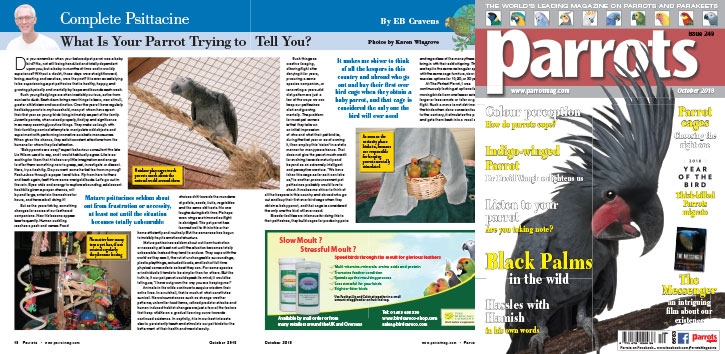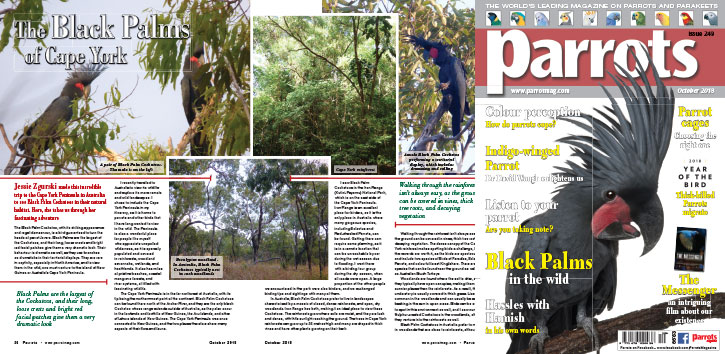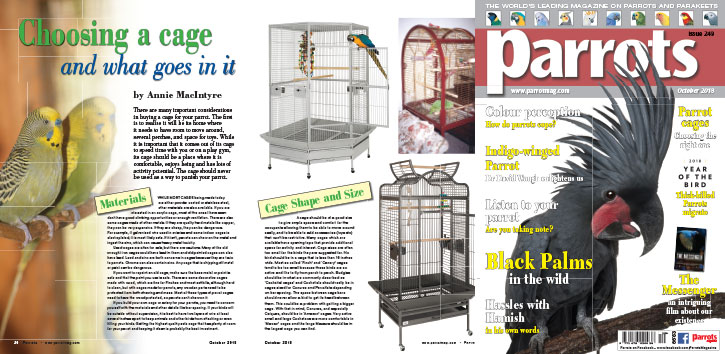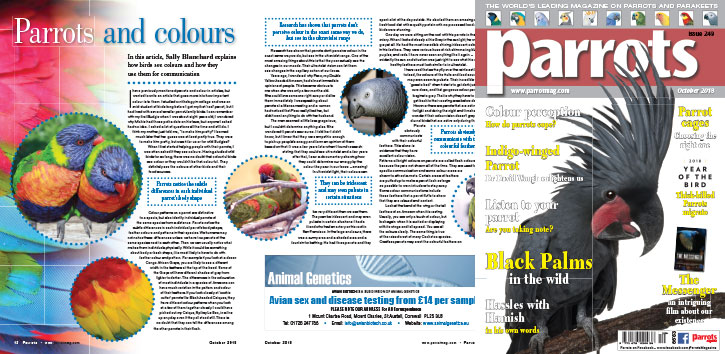
Complete Psittacine by Eb Cravens
Do you remember when your beloved pet parrot was a baby bird? No, not still being hand-fed and totally dependent upon you, but a baby in months of time and in worldly experience? Without a doubt, those days were straightforward, loving, exciting and carefree, were they not? It is ever so satisfying to be experiencing a pet psittacine that is healthy, happy, and growing physically and mentally by leaps and bounds each week.
Such young fledglings are often insatiably curious, active from sunrise to dusk. Each dawn brings new things to learn, new stimuli, greater athleticism and coordination. Over the years I have regularly had baby parrots in my household, many of whom have spent their first year as young birds living intimately as part of the family. Juvenile parrots, when raised properly, find joy and significance in so many seemingly routine things. They make us laugh with their fumbling comical attempts to manipulate odd objects and experiment with performing innovative acrobatic manoeuvres. When given the chance, they solicit constant attentions from the humans for whom they feel affection.
“Baby parrots are easy,” expert behaviour consultant the late Liz Wilson used to say, and I would habitually agree. Life is so exciting for them that it takes very little imagination and energy to offer them something new to grasp, eat, investigate or dissect. Here, try a fresh fig. Do you want some herbal tea from my mug? Peek-a-boo through a paper towel tube. Fly from here to there and back again, fast! Have some marigold buds. Let’s go out in the rain. Eyes wide and energy to explore abounding, adolescent hookbills given a proper chance, will by and large, entertain themselves for hours, and have a ball doing it!
Buy Now!

By Jessie Zgurski
The Black Palm Cockatoo, with its striking appearance and regal demeanour, is a bird guaranteed to turn the heads of parrot-lovers. Black Palms are the largest of the Cockatoos, and their long, loose crests and bright red facial patches give them a very dramatic look. Their behaviour is dramatic as well, as they use branches as drumsticks in their territorial displays. They are rare in captivity, especially in North America, and to view them in the wild, one must venture to the island of New Guinea or Australia’s Cape York Peninsula.
I recently travelled to Australia to view its wildlife and explore its more remote and wild landscapes. I chose to include the Cape York Peninsula in my itinerary, as it is home to parrots and other birds that I have long wanted to view in the wild. The Peninsula is also a wonderful place for people like myself who appreciate unspoiled wilderness, as it is sparsely populated and covered in rainforests, woodland savannahs, wetlands, and heathlands. It also has miles of pristine beaches, coastal mangrove forests, and river systems, all filled with fascinating wildlife.
The Cape York Peninsula is in the far northwest of Australia, with its tip being the northernmost point of the continent. Black Palm Cockatoos can be found there north of the Archer River, and they are the only black Cockatoo whose range extends outside of Australia, as they also occur in the lowlands and foothills of New Guinea, the Aru Islands, and other off-shore islands of New Guinea. The Cape York Peninsula was once connected to New Guinea, and the two places therefore share many aspects of their flora and fauna.
Buy Now!

By Annie MacIntyre
There are many important considerations in buying a cage for your parrot. The first is to realise it will be its home where it needs to have room to move around, several perches, and space for toys. While it is important that it comes out of its cage to spend time with you or on a play gym, its cage should be a place where it is comfortable, enjoys being and has lots of activity potential. The cage should never be used as a way to punish your parrot.
While most cages being made today are either powder coated or stainless steel, other materials are also available. If you are interested in an acrylic cage, most of the ones I have seen don't have good climbing opportunities or enough ventilation. There are also some cages made of other metals. If they are quality hard metals like copper, they can be very expensive. If they are cheap, they can be dangerous. For example, if galvanised wire used in aviaries and some indoor cages is electroplated, it is most likely safe. If it isn't, parrots can chew on the metal and ingest the zinc, which can cause heavy metal toxicity.
Used cages are often for sale, but there are cautions. Many of the old wrought iron cages could have lead in them and old painted cages can also have lead. Lead and zinc are both concerns in cages because they are toxic to parrots. Chrome can also contain zinc. Any cage that is chipping off metal or paint can be dangerous.
Buy Now!

By Sally Blanchard
I have previously mentioned parrots and colour in articles, but wanted to write an article that goes more into how important colour is to them. I studied ornithology in college and was an avid student of birds long before I got my first ‘real’ parrot, but I had lived with several smaller parrot-family birds. I can remember with my first Budgie when I was about eight years old, I wondered why Mickie had those polka dots on his face, but anyone I asked had no idea. I asked a lot of questions all the time and still do. I think my mother just told me, “to make him pretty.” I learned much later that her guess was at least partly true. They were to make him pretty, but was it for us or for wild Budgies?
When I first started helping people with their parrots, I was often asked if they see colours. Having studied wild birds for so long, there was no doubt that colourful birds see colour or they wouldn’t be that colourful. They definitely see the colours of other birds and their food sources.
Colour patterns on a parrot are distinctive to a specie, but also identify individual parrots of the same species from a distance. Parrots notice the subtle differences in each individual parrot's body shape, feather colours and patterns in their species. We humans may not notice these differences unless we have two parrots of the same species next to each other. Then we can usually notice what makes them individuals physically. While it could be something about body or beak shape, it is most likely to have to do with feather colour and pattern. For example if you look at a dozen Congo African Greys, you are likely to see a different width in the feathers at the top of the head. Some of the Greys will have different shades of grey from lighter to darker. The differences in the colouration of most individuals in a species of Amazons can have much variation in the pattern and colour of their feathers. If you look closely at ‘cookie cutter’ parrots like Black-headed Caiques, they have different colour patterns when you look at a few of them together closely. I could have picked out my Caique, Spikey Le Bec, in a line up any day even if they all stood still. There is no doubt that they can tell the differences among the other parrots in their flock.
Buy Now!




